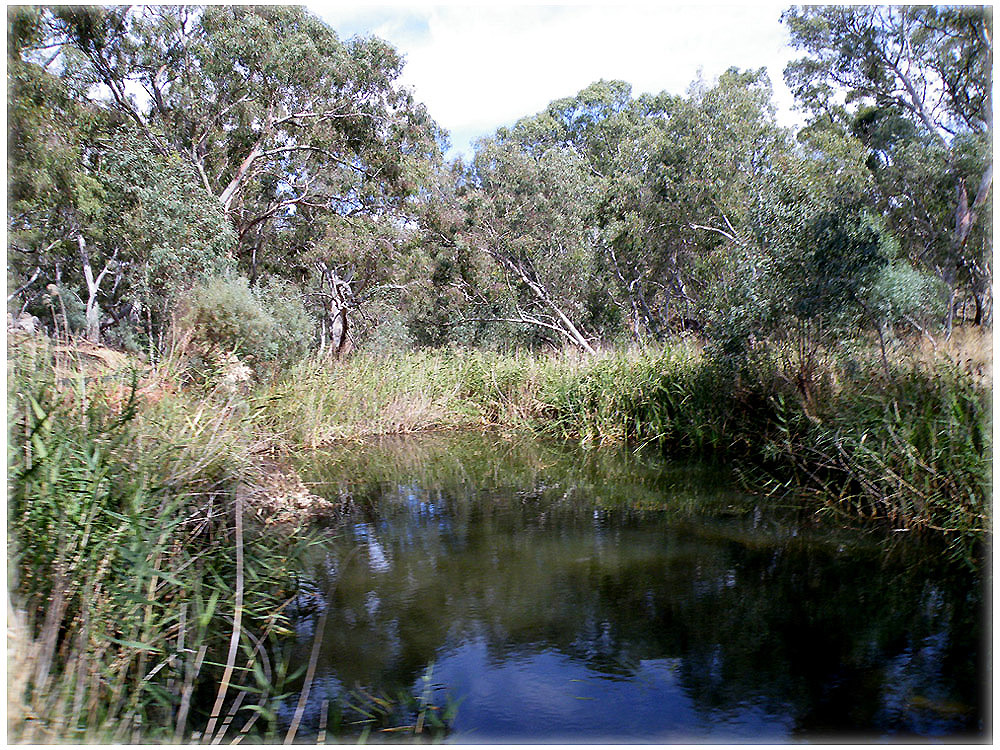
Woady Yaloak River, Springdallah - 2015. Courtesy Sydenham Collection.
Well and truly over the gold rush, Springdallah nowadays, has a host of peaceful farms and mine relics to view, plus some great bush camping spots, near the Woady Yaloak River.
Guire Coates.
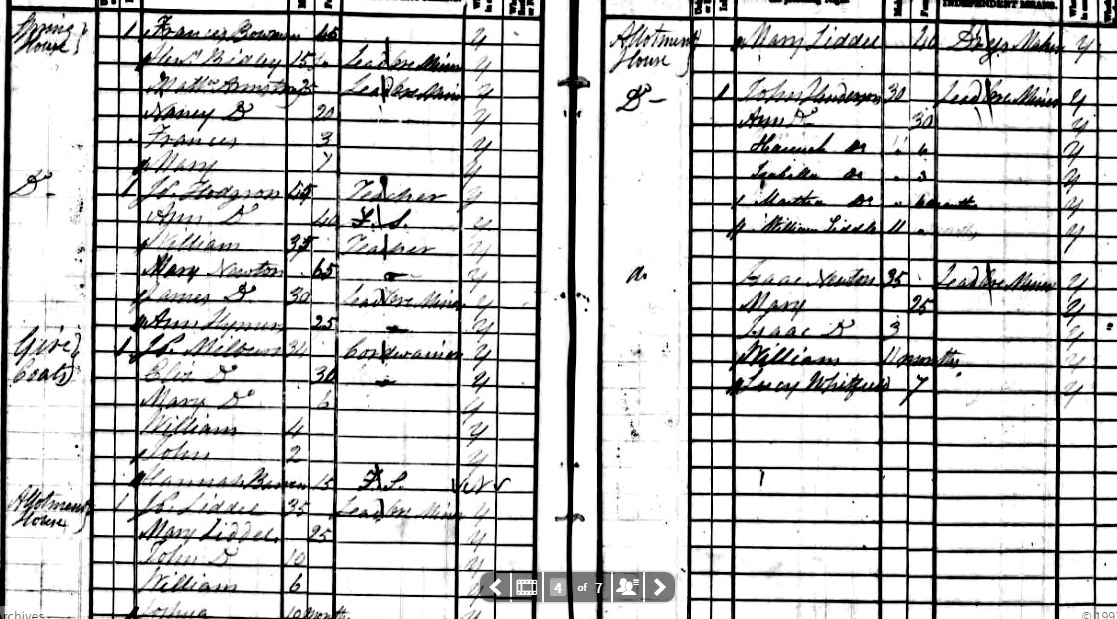
Gire Coates where J. Milburn lived in 1841, with neighbours Joshua Liddell and wife Mary Coulson, and Matthew & Nancy Armstrong in the Allotment house next door.
The question of "Guire Coates ( Allendale )" in this letter was initially a bit of a mystery, as our first clue was James Armstrong's uncle Miles Armstrong married a Sarah Coates, yet searching for a person named Guire came up zero in the usual resources. A few early references of the 1700s were found regarding an Edward Armstrong born 1745 of "gier coates", implying it may have been an Armstrong family property of some standing. As it eventuated, James Armstrong's cousin Mary, daughter of John Armstrong and Mary Craig, married Joseph Lee, whose three younger brothers, Matthew and two Josephs, were registered as being born at Giercoats. Sadly these three Lee brothers died quite young, with Matthew surviving the longest, some 19 years.
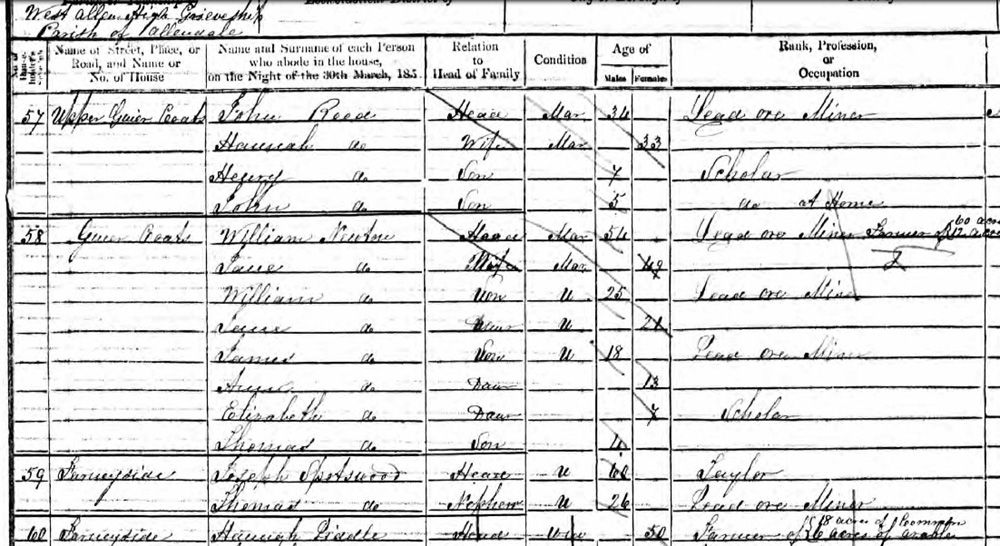
Gire Coates where William Newton lived in 1851, and Mary Liddell nee Coulson, widowed, still lived next door .
The above farms were apparently owned by Edward Fairless of Ninebanks in the mid 1700s and later by Blackett. Further research confirms "Guire Coates" was a recognized location of these times in Ninebanks / West Allen, being very close to numerous other family abodes namely Dry Burn, Birkhott, Mopehead, Hesley Well, Wolf Cleugh, The Nook, and Carr Shield, with neighbouring Guire Coates listed as a 17 acre farm in this region, adjacent to High Greenley Cleugh.
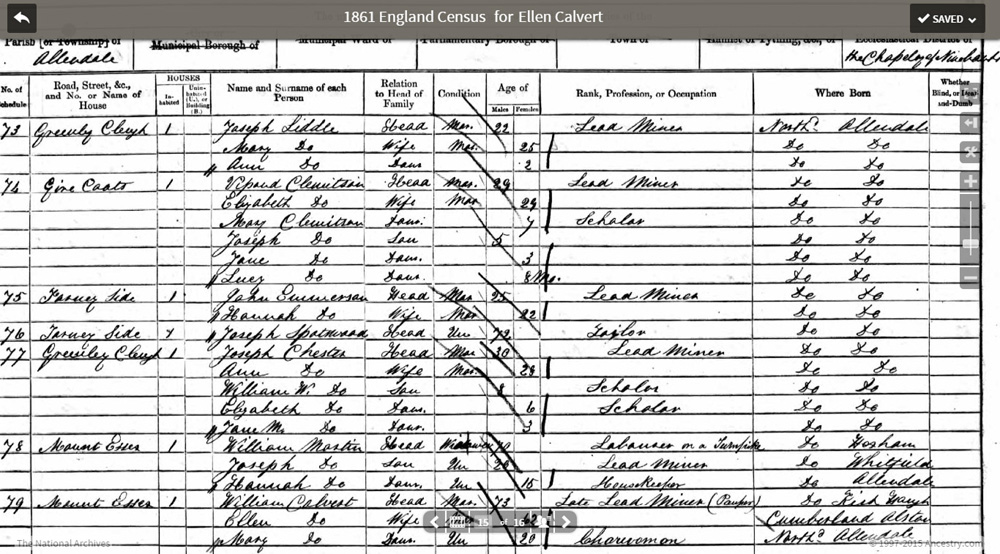
1861 Census showing property name of Gire Coats, the residence of Vipond Clementson and Elizabeth Armstrong, the recipients of this letter in 1863.
Devils Kitchen

A classic photo of the Try Again Gold Mine circa 1860, courtesy Victorian Public Records Office and Joan Hunt.
Devils kitchen is a stunning steep gully located at the bottom of what was the Piggoreet township. Other family members, William Armstrong, William Calvert, John Russell Calvert, Thomas Broadwood, Joseph Coulson, Hugh Coulson, John Liddell, and John Hewitson, plus family friend Parkin Lee, worked at the
Try Again Gold Mine at Devils Kitchen,
or the Cleft in the Rock Gold mine, at Piggoreet.


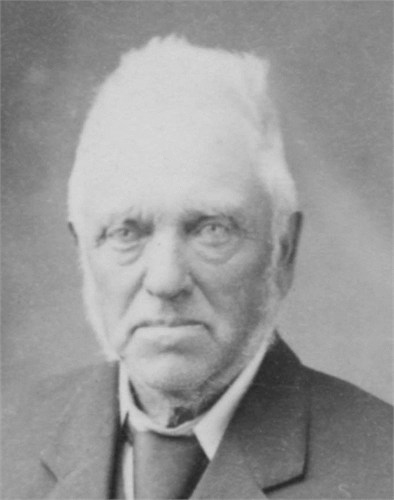
Jane Calvert nee Coulson, sister of Hugh and Joseph Coulson, with her husband John Russell Calvert.
Photos of Jane Calvert and John Russell Calvert reproduced Courtesy http://arrow.monash.edu.au/hdl/1959.1/70376
Written permission to use - Federation University Centre Gippsland Studies, Monash University Research Repository.
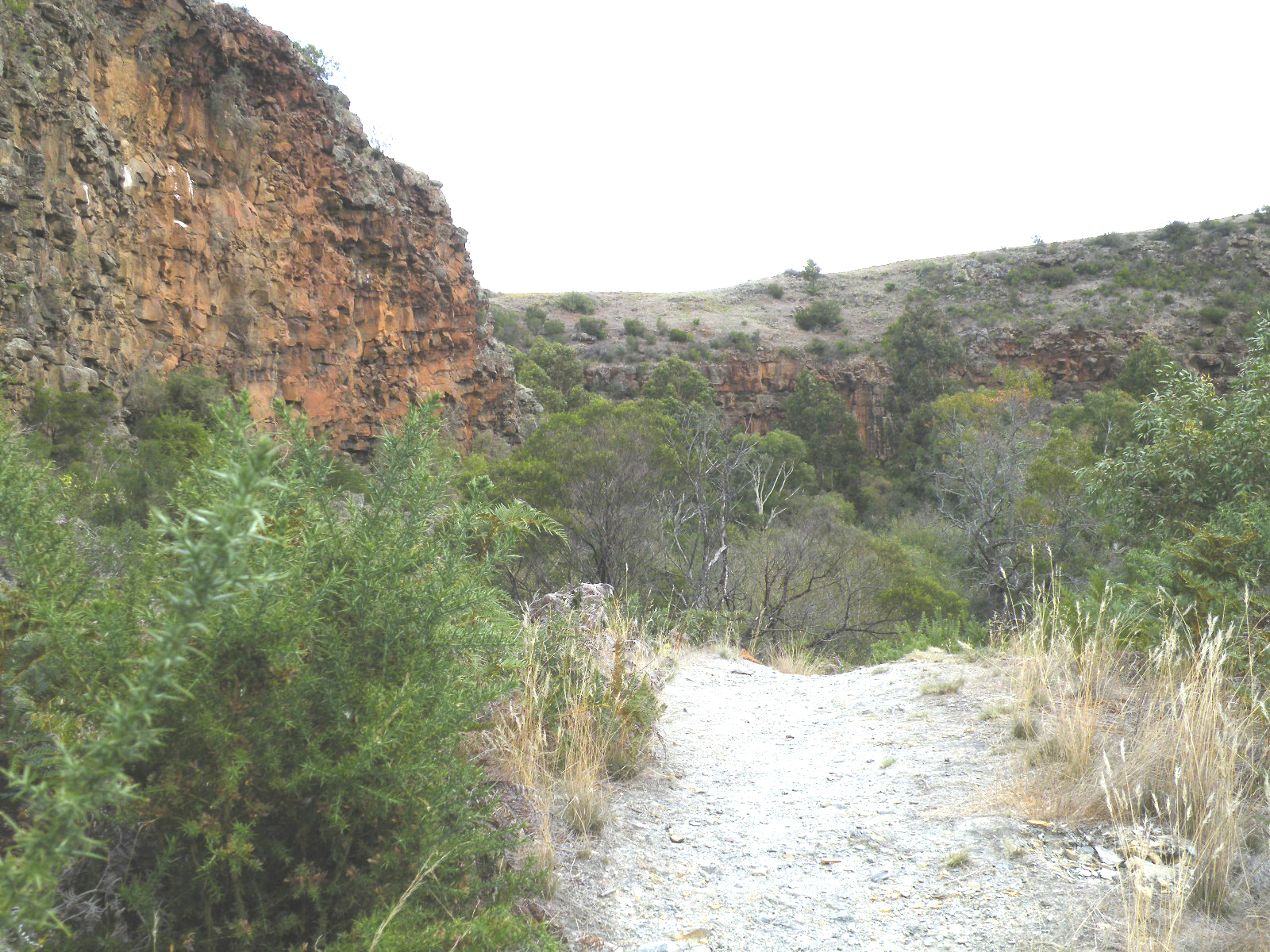
Site of The Try Again Gold Mine at Devils Kitchen in 2015 - Courtesy Researcher Mixo Sydenham.
Brother Joseph Armstrong.
Briefly Joseph Armstrong was born in Allendale on 17 Mar 1834, and did not come to Australia until the second main influx of the Armstrong family arrived in Melbourne in 1884 on board the Gulf of Carpentaria. He remained a bachelor all his life, and he spent his later years of life living and working on brother William's large farm ( along with James too ) at Sarsfield on the edge of the Nicholson River in East Gippsland.

1903 Census of brothers Joseph, James, and William living together on the farm at Sarsfield near the Nicholson River.
Mary Teasdale and Thomas Teasdale.
In the last paragraph, James refers to Mary Teasdale as a niece, suggesting Mary must have been a daughter of one of his sisters who married a Teasdale gent. It seems James was up to date regarding his brother Joseph being with Mary Teasdale at Gilsland, about 16 miles from both Ninebanks and Allendale - perhaps it was a de facto marriage or potential relationship that failed, yet no confirmation was located re a niece named Mary Teasdale. Coincidentally brother John Wilkinson Armstrong married a Mary Teasdale nee Watson in Victoria on 9 Feb 1863, about 8 months before this letter was written. From the content, general accuracy and diligence in writing a detailed and informative letter, its seems like James was quite a good communicator and very family orientated, so it's not very likely he confused his "niece Mary Teasdale" with a potential sister-in-law he may not have even known about.
The request to pass on news to Thomas Teasdale about his uncle living very nearby, also proved impossible to prove a family connection to Mary Teasdale, due to minimal information to research with. Our researcher is still investigating both Mary and Thomas Teasdale, and a mystery Teasdale uncle who lived within walking distance from Springdallah.

Page two of James Armstrong's letter of 1863.
Smythesdale - Post Office.
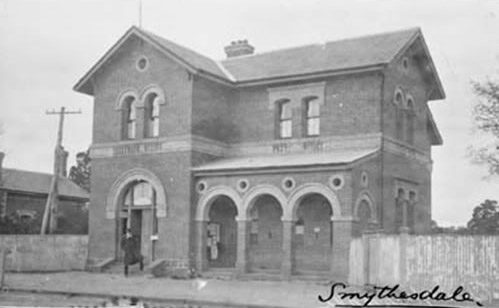
Smythesdale Post Office circa 1870. Courtesy stampboards.com
This is pretty much the view that George Armstrong, or whoever went to pick up their mail at Smythesdale, would have seen back in the time this letter was written.
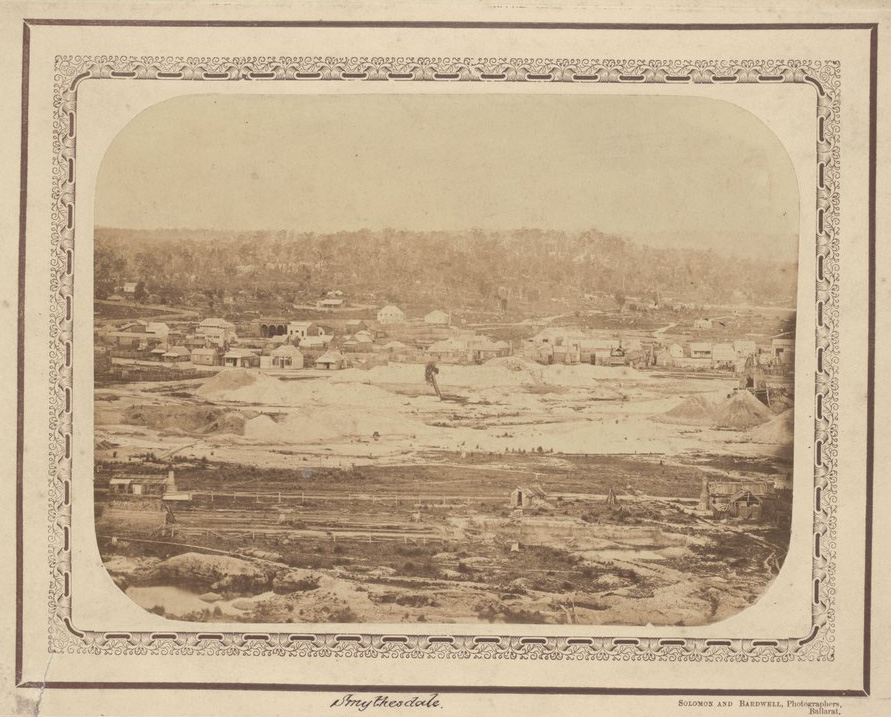
Smythesdale circa 1860s. Courtesy State Library of Victoria.
Smythesdale, located about 20 kilometres south west of Ballarat, is reputed to have reached its peak, population and size wise, around the 1870s. Its Gold rush fever had long diminished, and still is a quaint rural township.

Old time District map
The local Peru Gold Mining Company actually found gold adjacent to the Smythesdale Racecourse, and sold the odd scrip to diggers from Piggoreet.
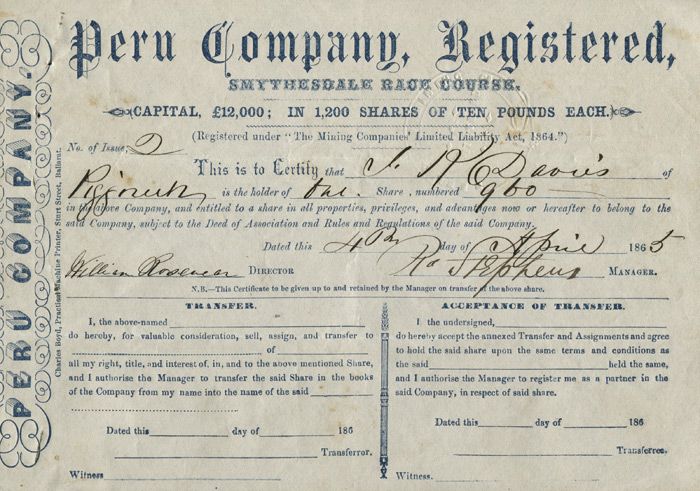
George Armstrong.

Family timeline for George J. Armstrong, a first cousin of James Armstrong.
Tracing George Armstrong from "the Old Country", initially raise some research difficulties, however referral to "old Nanny" on the next page of James Armstrong's letter, provided some great clues and evidence as to the background of who George Armstrong actually was. To the best of our investigations, Old Nanny actually was Ann Alice Armstrong, daughter of John Armstrong and Mary Craig, born in 1808 at Carrshield, and baptised "Nanny" at Ninebanks in Aug 1808. Ancestry.com records indicate Nanny Armstrong had 2 children, ( possibly out of wedlock ) being George J Armstrong, and Mary J Armstrong, both born at Haydon Bridge, Bishop Wearmouth, Northumberland.

Census of 1861 for George Armstrong, profession listed as Engine Fitter.
The wording by James, "We had George Armstrong down on a visit amongst his shipmates" resulted in confirming there was a George Armstrong from Northumberland issued a Masters and Mates Certificate, and seeing there was a trend during this time frame of Clippers being fitted with steam driven engines, its highly likely this George Armstrong had a nautical background before settling in Victoria.

Emigration record of George Armstrong in 1862, on board S.S. Great Britain.
In August in the year after this Census, 1862, George Armstrong arranged a trip from Liverpool to Victoria, on board the S.S. Great Britain. Going by the following newspaper cuttings, it would seem cousins James and George Armstrong were quite close; they shared Gold Mine interests on the diggings, and social events such as local horse racing at Ballarat.
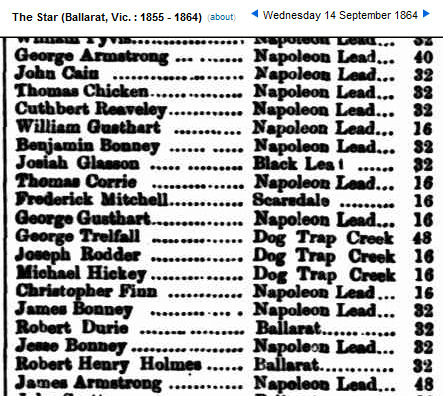
Listing of George Armstrong and James Armstrong as shareholders in the Sons of Freedom Gold Mine, Buninyong, 1864.
Our Richardson cousin Hugh Cochrane was one of the initial Shareholders of the Sons of Freedom in 1860, but must have sold his shares by this time.
George Armstrong had shares in the Prince of Wales Gold Mine at Morrisons in 1863, the Golden Rivers Gold Mine ( with John Russell Calvert ) at Tea Tree Creek in 1863, and the Saxby Gold Mine at Bulldog in Nov 1864,
George was involved in the Services Central Committee, and the Miners Horse Racing Club at Ballarat, in 1865.
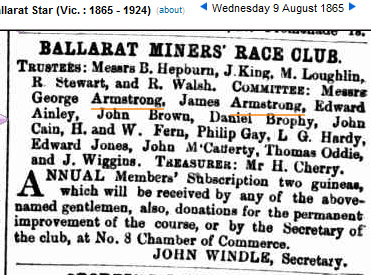
George Armstrong and James Armstrong as Trustees of the Ballarat Miners Horse Racing Club.
It's probably not a coincidence, that John Russell Calvert and his wife Jane Coulson became serious Race Horse breeders, with their own private race track at Mossiface, and James Armstrong shared a similar interest. Three references were found relating horses belonging to James Armstrong, all raced under the banner of the Ballarat Miners' Racing Club.
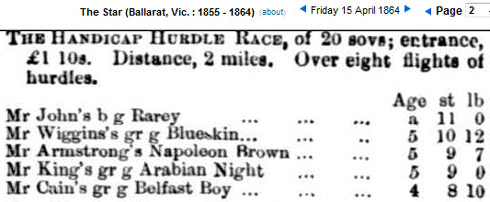

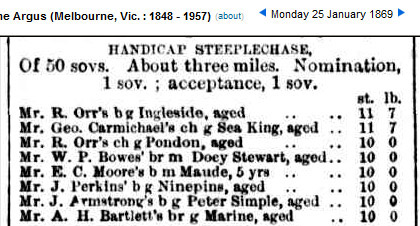
Johnson.
The name "Johnson" alone does not provide for much in the way of effective research material, therefore he has not been positively identified. The best possible clue located which resembles a Johnson contact in this area and time frame, is that William Johnson, who invested with James Armstrong, in the not-so-successful Archer Gold Mining Company at Springdallah in same year of this letter.
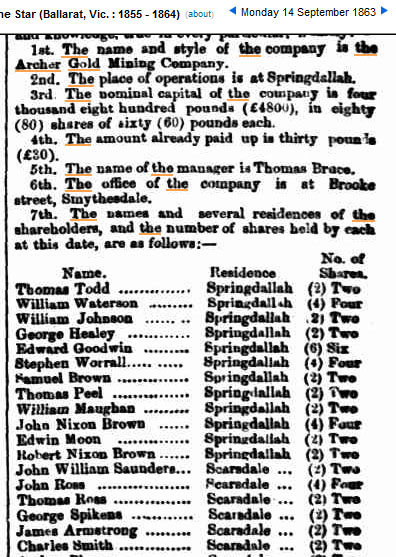
Having found very few errors in this letter of James, it is our researcher's opinion James was quite articulate when expressing himself, and it would be unlikely for him to mispell a surname like Johnson. However, it is possible James was referring to John Johnstone, a fellow Saxby Gold Mine shareholder with George Armstrong & Matthew Robson, as shown.
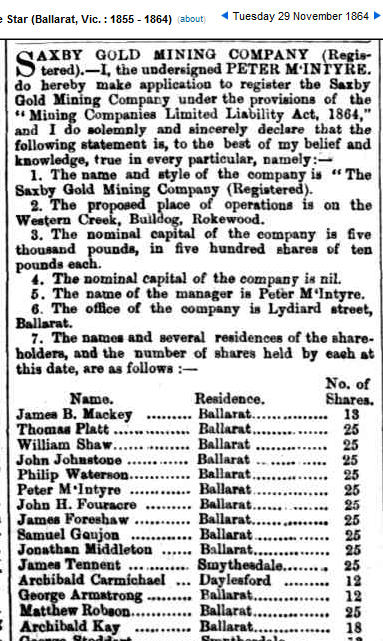
Saxby Gold Mine shareholders, George Armstrong, Matthew Robson, and John Johnstone in 1864.
Robson and Mathew.
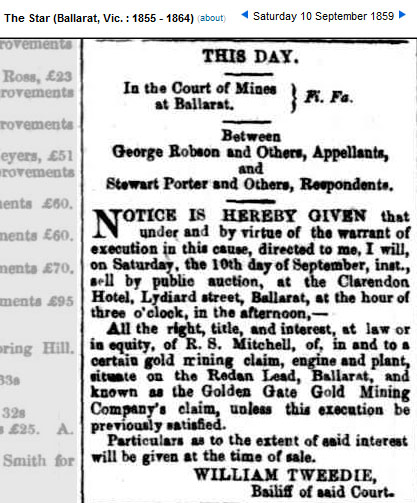

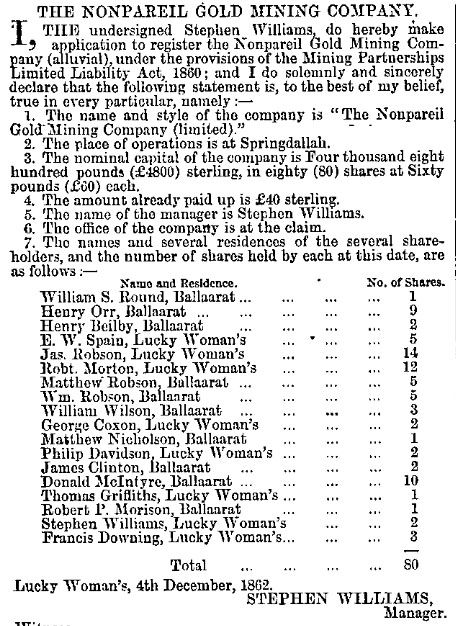
Regarding "Robson and Mathew" mentioned on this page, you have the choice of checking into four Robsons found to be in the area, being George Robson, James Robson, Matthew Robson, and William Robson. Take your pick! Our Richardson family is related via our connection to Elizabeth Hetherington, an ascendant who married George Robson, who was born at Allendale UK. in 1836, and died at nearby Pleasant Creek ( Stawell ) in 1913, so it's possible the "Robson" on this page, may have been this relative.
"Matthew" mentioned on this page, could have been anyone named Matthew within hundred miles or more. Logically, considering there was no Matthew Armstrong known as living locally, and mention of just a single Christian name, may imply this Matthew was someone very familiar and close to the recipient, Vipond Clementson, and someone living within a stones throw, eg. James sister's ( Anne Armstrong ) husband Matthew Clementson, from Piggoreet.
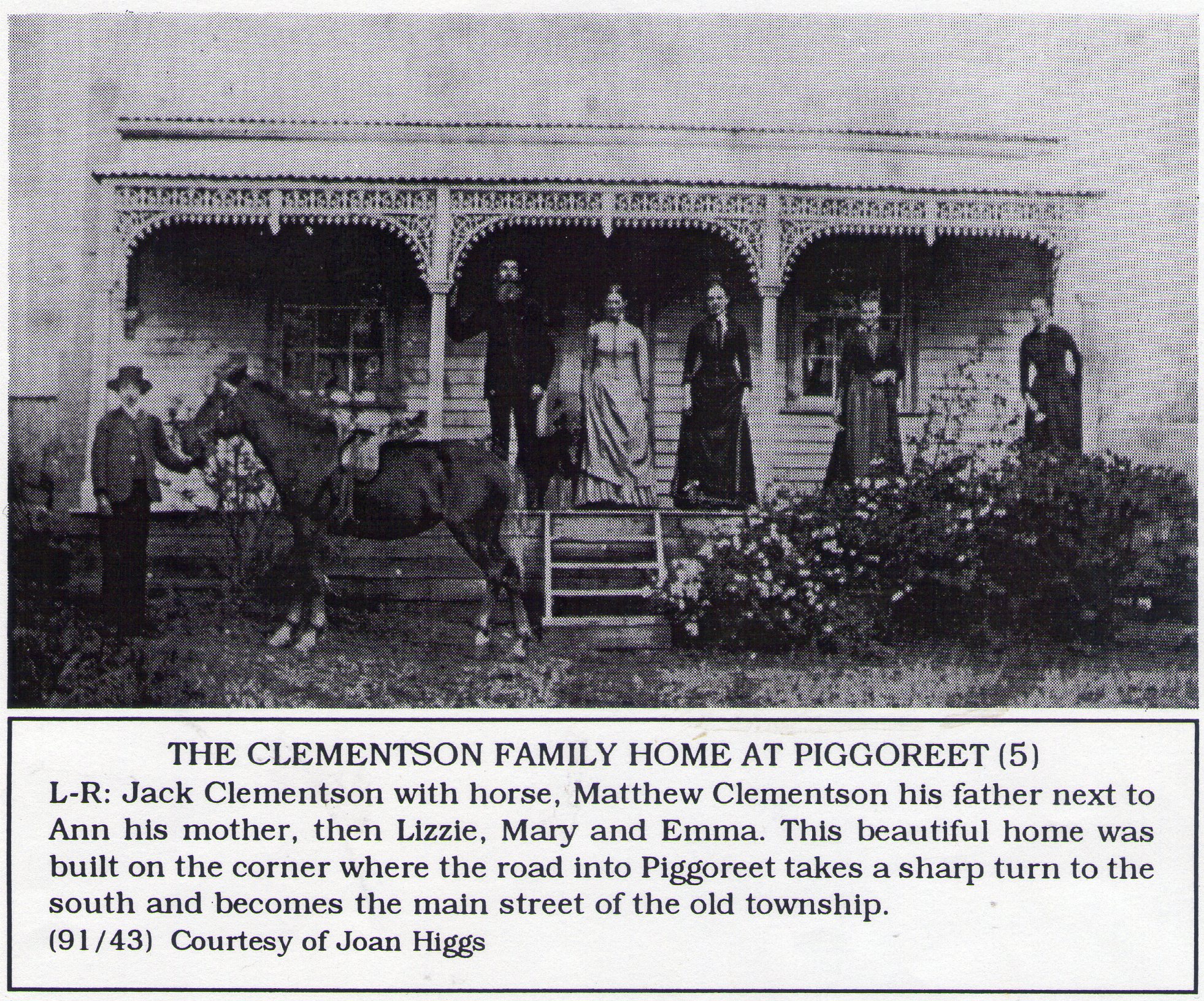
The Clementson house at the top end of Piggoreet township, was apparently known and regarded as "Clementsons Corner". Courtesy the late Joan Higgs & Woady Yaloak Historical Society.

Lizzie noted as a Pupil Teacher at nearby Grand Trunk School in 1887. Courtesy Victorian Government Gazette.
There's a bit of an odd coincidence worth a mention here - that Parkin Lee noted on this page, was a serious investor at the Grand Trunk Gold mine, and Lizzie Clementson pictured on her front porch above, was a teacher at the local Grand Trunk school, plus our Cochrane cousins, Robert and Emma Catherine, taught at the same school together, so long ago.
Willie Clementson of Alston.
"Willie" William Clementson was a cousin of Matthew Clementson, son of Joseph Clementson and Elizabeth Pickering born in Allendale. Willie emigrated to Australia on board the S.S. Great Britain with Matthew and other cousins - they were the same age of 28 on this voyage. Willie had married Elizabeth Iceton also from Allendale only a month or so prior to their departure from Liverpool. Willie and Elizabeth had 2 sons at Springdallah between 1865 and 1868, and had a daughter at Rutherglen later in 1877.
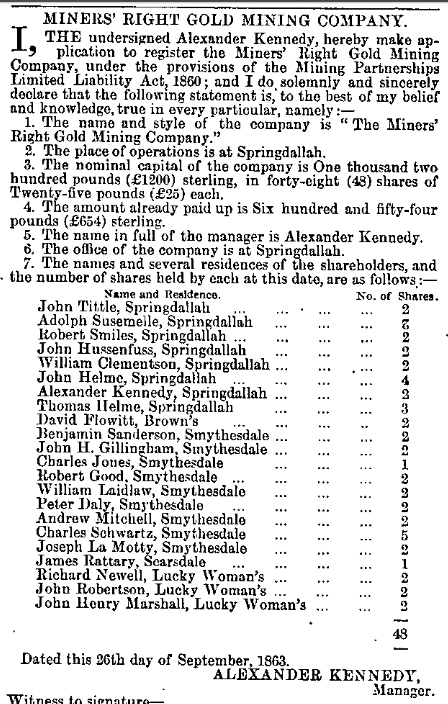
Shares held by William "Willie" Clementson in the Miners Right Gold Mine at Springdallah in Oct 1863.
The above Shareholder List is the only Victorian record found for Willie, apart from birth records of his children.
Joseph Hudspith.
Speaking of Matthew Clementson, and the point that friends and neighbours often networked skills and resources in the Lead Ore Mines and on the Gold Fields too, Matthew Clementson's family were neighbours with Joseph Hudspith's family as young lads, back at Wolf Cleugh in district 16 of Allendale, in 1841.
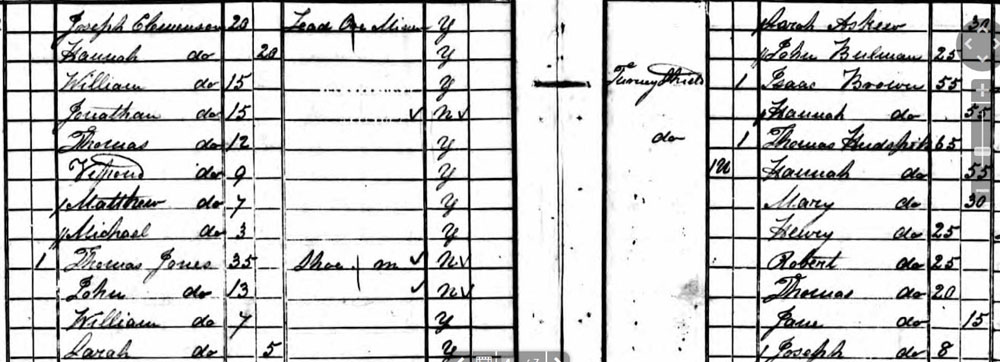
1841 Census Matthew Clementson aged 7 and Joseph Hudspith aged 8 as neighbours at Wolf Cleugh Allendale UK.
The Clementson and Hudspith families were still neighbours on the next Census in 1851. Neither an emigration record nor a marriage record had been located for Joseph Hudspith, however one Shareholder list was found for him, at the New Republic Company at Wendouree, on the edge of Ballarat, in 1860.
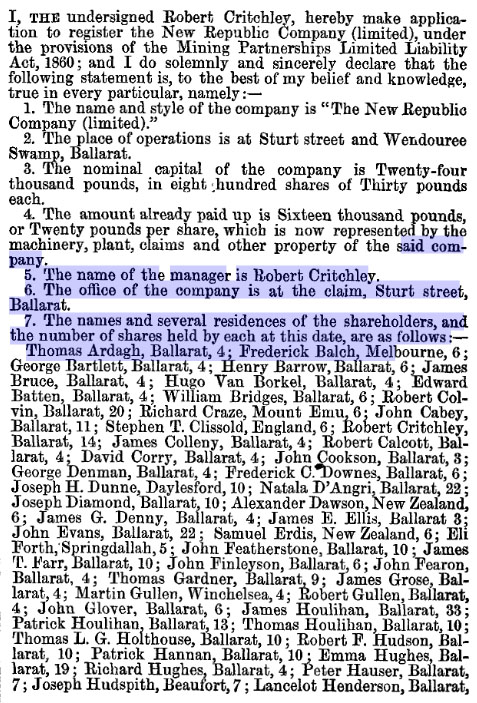
Joseph Hudspith, shareholder New Republic gold mining Company at Wendouree in 1860.
The only other point of reference for Joseph in Victoria was his death record.
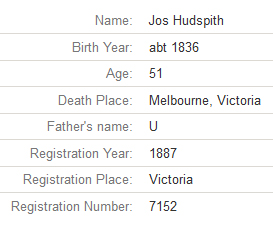
Ancestry death record for Joseph Hudspith.
Smythes (Creek).
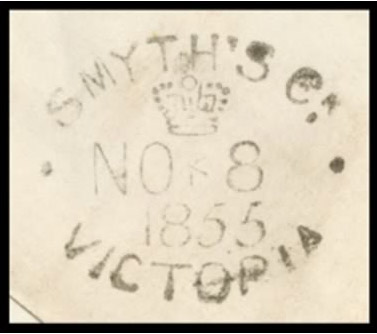
Smythes Creek Post Office Datestamp of 1855. Courtesy stampboards.com
"Smythes" as it was known to local Diggers back then, is now known as Smythes Creek situated between Sebastopol and Smythesdale.
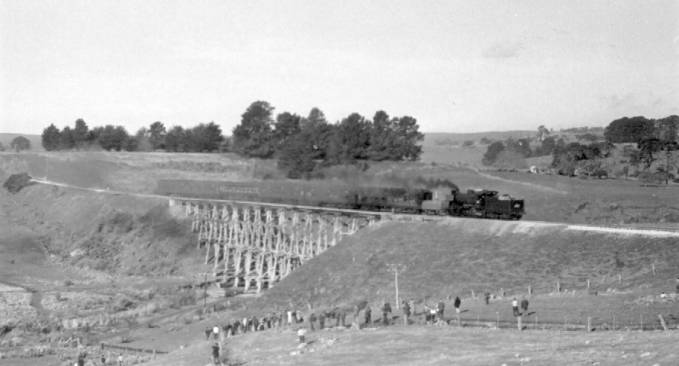
Smythes Creek bridge near Newtown date unknown. Courtesy brownfarm.com.au
Matthew Dixon of Dryburn.
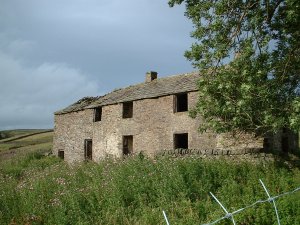
Dryburn Hall. Courtesy Fivenine.co.uk
Research indicates "Matthew Dixon of Dryburn" as mentioned by James Armstrong, was the fourth child of Matthew Dixon ( senior ) and Ann Robinson from Allendale. The 1841 census advises us Matthew Dixon ( senior ) had passed away, and Ann Dixon nee Robinson was managing the family farm at Spring House, with her 4 children, Robert, a Lead Ore Miner, Jane, Adah, and this Matthew Dixon. Spring House is adjacent to Birkhott ( next door to Dryburn Hall ), where the eldest Dixon boy Robert, ended up farming 32 acres in 1861, with his sister Adah, and daughter Hannah.

1841 Census for Matthew Dixon's family - 2 farms away from Dry Burn Hall.
Matthew booked a voyage on the S.S. Great Britain, to emigrate to Australia in Aug 1854, quite a relatively early comer to the Victorian gold diggings. Matthew Dixon's abode was noted by James Armstrong to be "40 miles up the country at Pleasant Creek", this gold mining township settled in 1853, was actually located about 80 miles from Piggoreet, and was renamed Stawell 1861, in honour of Sir William Foster Stawell.

Emigration record of Matthew Dixon in 1854. It is not known when his future wife Mary Ann Conway arrived in Victoria.
According to James Armstrong's info in his letter of 1863, that by this time, Matthew Dixon had made his way to the Victorian Gold Diggings at Pleasant Creek, was married ( to Mary Ann Maria Conway ) with 2 children, being Robert and Ada Dixon. Victorian Birth records indicate Matthew and Mary Ann Dixon ended up having a total of 9 children, 3 sons and 6 daughters, all born at Pleasant Creek, between 1860 and 1876.
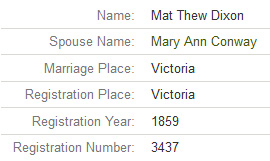
Marriage record of 1859 in Victoria for Matthew Dixon and Mary Ann Maria Conway, daughter of Peter Conway and Bridget Kaffe or possibly O'Keefe.
Matthew Dixon's name was also found on a document ( as an initial shareholder ), relating to forming of the Extended Cross Reef Quartz Mining Company at Pleasant Creek ( Stawell ) in July of 1868, however little more is known about Matthew and his family, until his death at Kew, a suburb of Melbourne in 1890.

Original Shareholder list re Matthew Dixon, of the Extended Cross Reef Mine at Pleasant Creek in 1868.
Courtesy Document Auctions at antiquesreporter.com.au
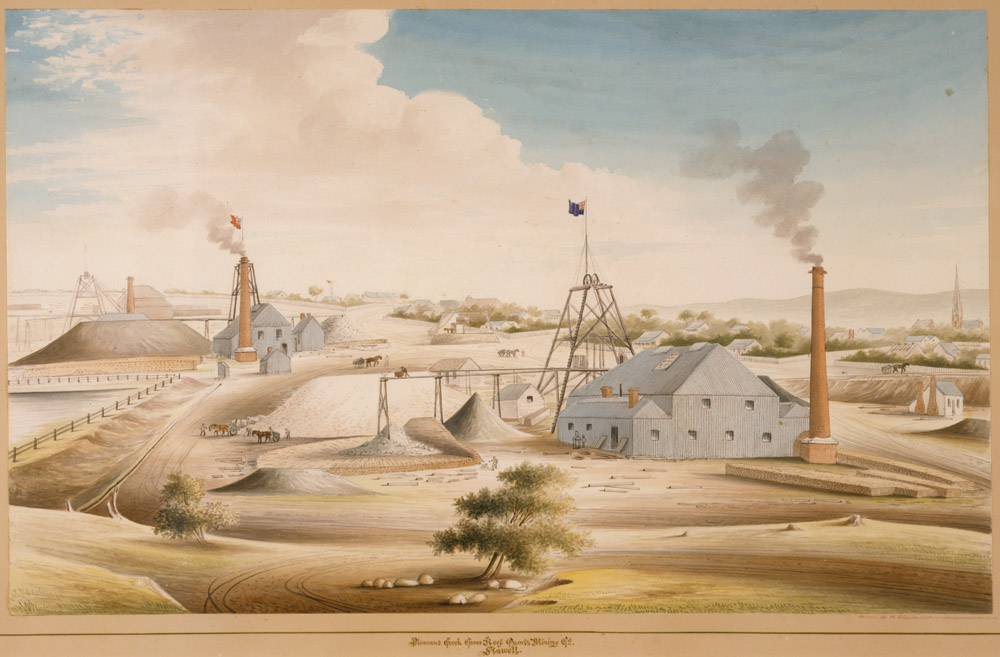
Painting of Extended Cross Reef Mine by William Tibbits, circa 1870. Courtesy State Library Vic.
Pleasant Creek - Stawell, Victoria.

Longfield St, Pleasant Creek in 1866. Courtesy Stawell Historical Society.
Pleasant Creek, later known as Stawell, was also quite a Gold Mining centre in its heyday. As it turned out, one of John Liddell's brothers, Joshua Liddell, and his wife Ann Parker, decided to settle and lived out their lives at Deep Lead, on the edge of Stawell township.
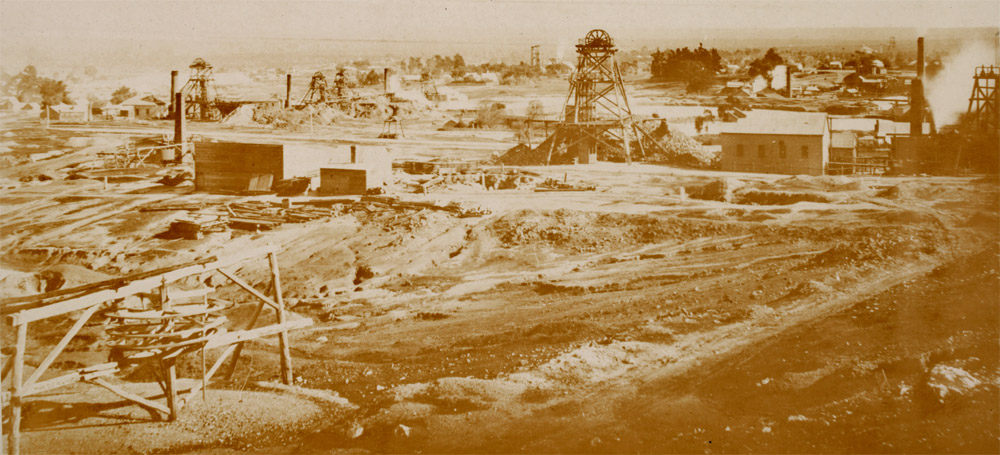
Wide spread mining activities at Pleasant Creek ( Stawell ) about 1860. Courtesy State Library Vic.
Lidddl and Jane - Janes place.
Briefly John and Jane Lee nee Liddell, ran the Try Again Hotel at Piggoreet, which was next door to the Archer Mine shaft on one side, and on the other side was where Matthew Clementson and his wife Anne nee Armstrong lived, at the top end of town. John and Jane were regarded as quite colourful characters by any means of comparison, and its no wonder James Armstrong took Matthew Dixon there for "two or three nobblers together" and to catch up with John Liddell again, for the first time in five years.
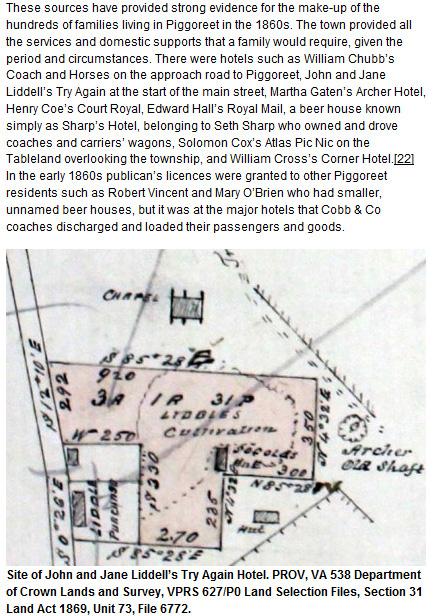
Land Selection plan for John and Jane Liddell's Try Again Hotel - Courtesy Joan Hunt.
Although The Try Again Hotel, adjacent to the Archer Shaft, was actually named after the Gold Mine of the same name, the pub was known locally as "Janes Place", as Jane Liddell ( nee Lee ) spent most of her time managing the bar, dances, card games and so forth, while John was fairly involved with the Try Again Gold Mine. Sadly Jane passed away from alcoholic poisoning, and John remarried Emma Howson, and still remained childless.
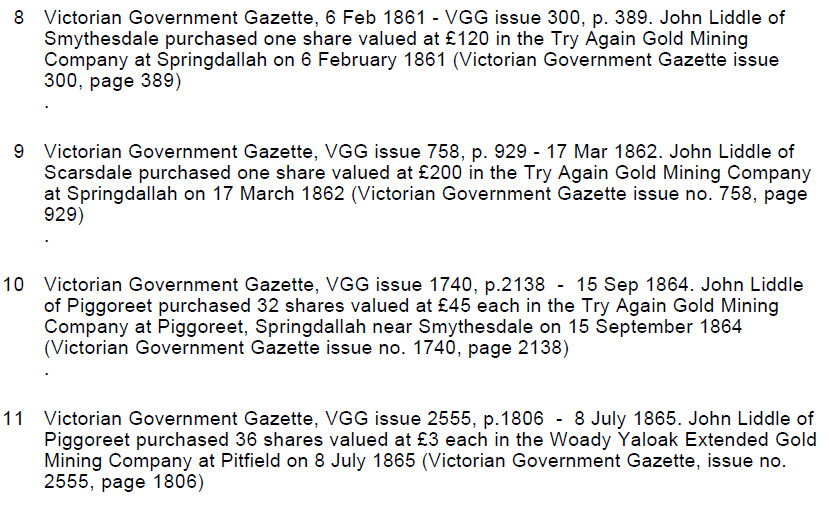
Summary of Gold Mining Shares held by John Liddell from the Victorian Government Gazettes.
There is a wealth of information about John and Jane Liddell, and their family history, at Liddell Family Tree.
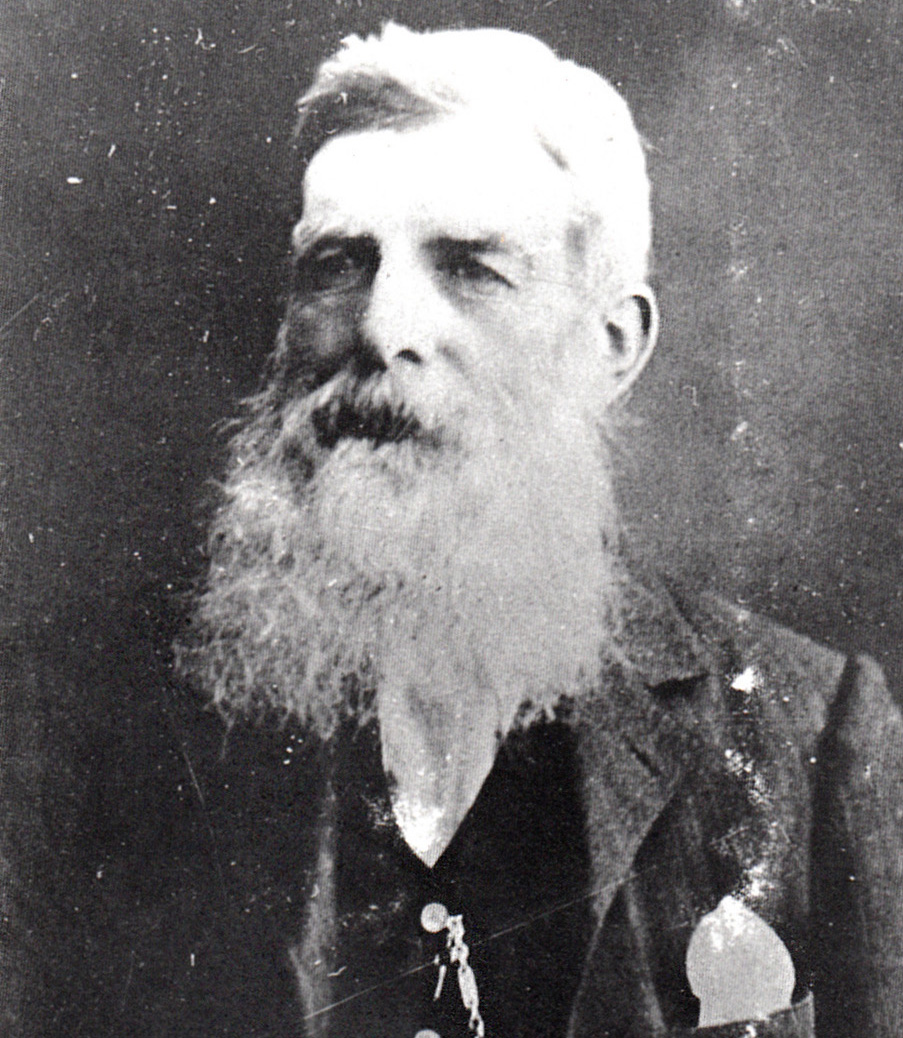

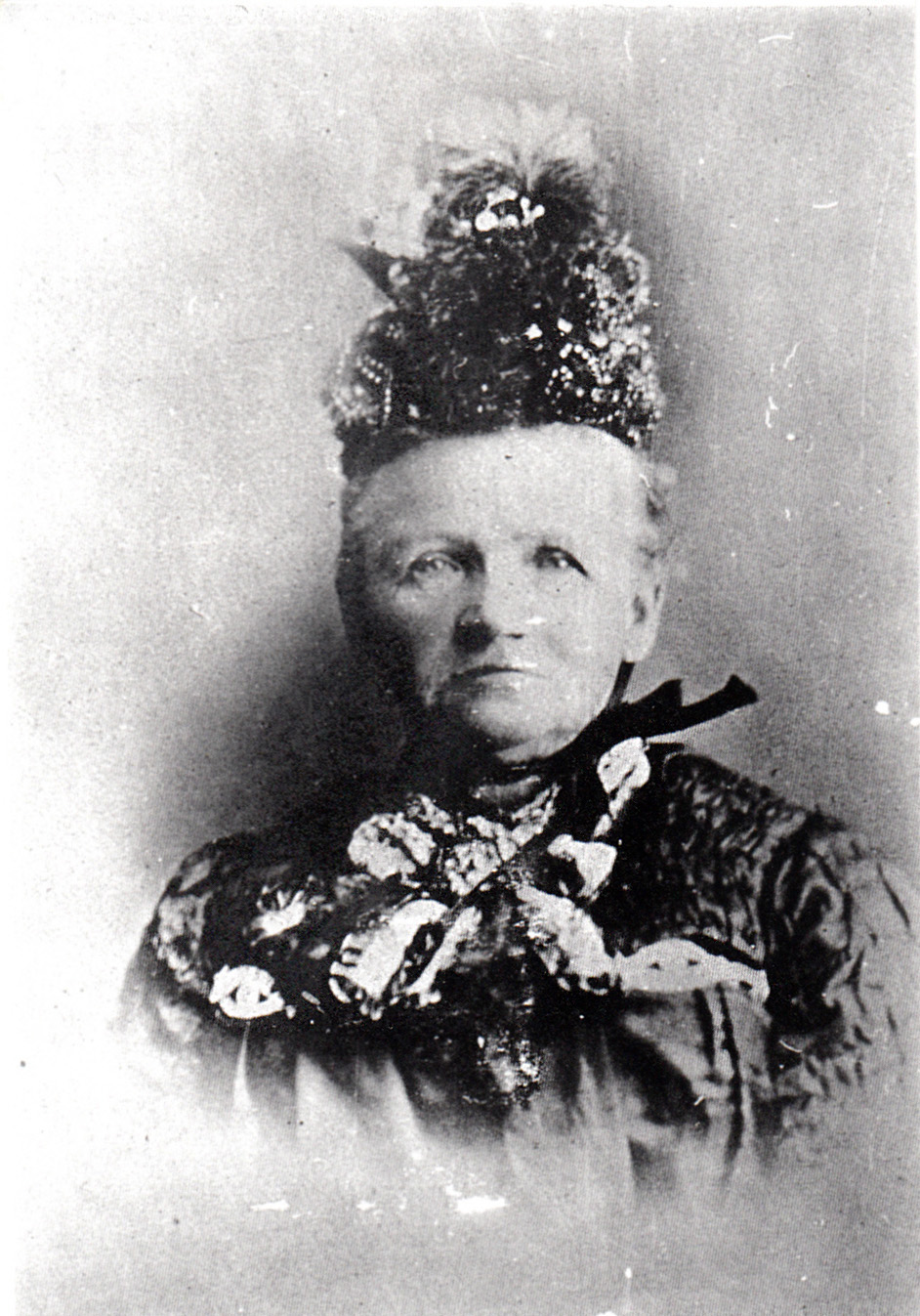
John Liddell's brother Joseph, with his wife Mary Liddell nee Calvert, sister of William Calvert as mentioned in this letter. William was brother of John Russell Calvert. Family photos courtesy J. R. ( Jack Cunningham ) Swan Reach, Victoria.
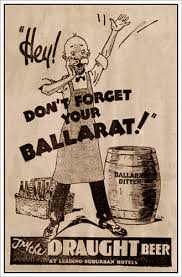
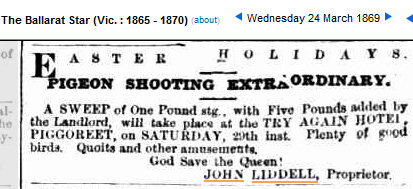
A pigeon shoot sweep at Easter was probably a great local activity, and a good excuse for a Ballarat Beer.
Thomas Broadbent.
Nothing to date has been definitely confirmed as to personal and family details of a Thomas Broadbent, which fits the common parameters of individuals, usually miners from northern England, as mentioned by James Armstrong. However research into the Gold Mining industry near Ballarat Victoria, a Thomas Broadbent located, appears was well cashed up in the early 1860s, and able to register the Essex Gold Mining Company ( as Manager and major Shareholder ), along with over 40 other shareholders early in 1862.
The location of the Essex Company mine, was listed as "Swamp Lead", "Suburban Lead", and "Wendouree Swamp", all locations on the northern edge of Ballarat, in the region of Learmonth and Creswick Roads.
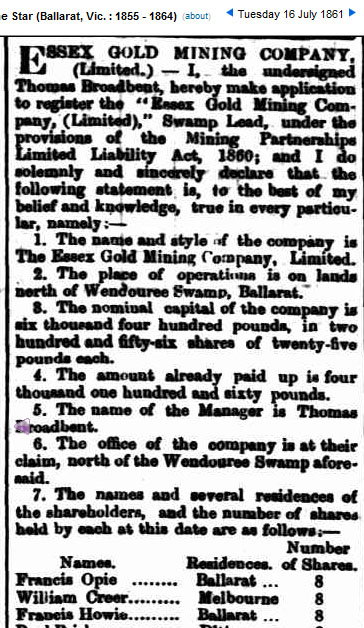

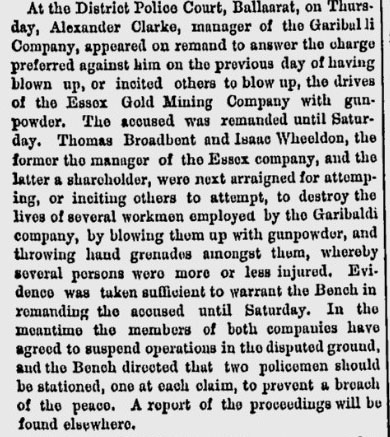
Two of minimal references found to date re Thomas Broadbent - seems like he was an interesting character.
The Garibaldi Company mentioned as the party rising charges against Thomas Broadbent and Isaac Wheeldon ( a fellow shareholder in the Essex Company ), of attempted sabotage with gunpowder in June 1863, as outlined in the article above right, was also listed as located at Swamp Lead / Wendouree Lead, obvious Gold Mining competition.
William Calvert.
William Calvert, born in 1824 at Kirkhaugh, to William Calvert ( senior ) born 1791 and Ellen Allison born 1796 at Alston, was a key figure, with the success and development of many of our Richardson / Coulson / Calvert / Liddell relations, along with the input and activities of his younger brother John Russell Calvert, as pictured near the top of this page.
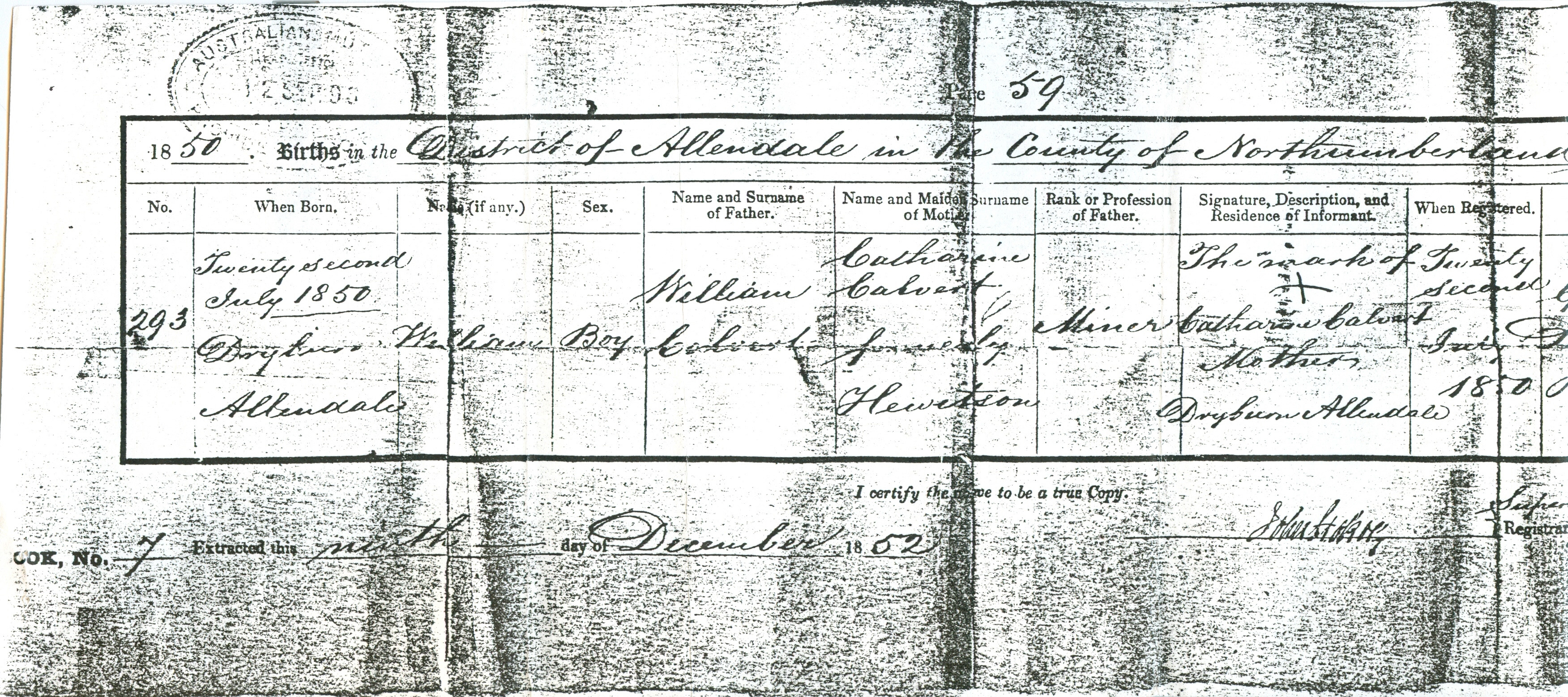
Birth Certificate of William Hewitson Calvert of 1850 at Dryburn.
William married Catherine Hewitson over the border in Scotland in 1849, and they had only one surviving son William Hewitson Calvert, born at Dryburn, in 1850.

Emigration record of brothers William Calvert (Junior) & John Russell Calvert on board the Ann Dashwood in 1853.
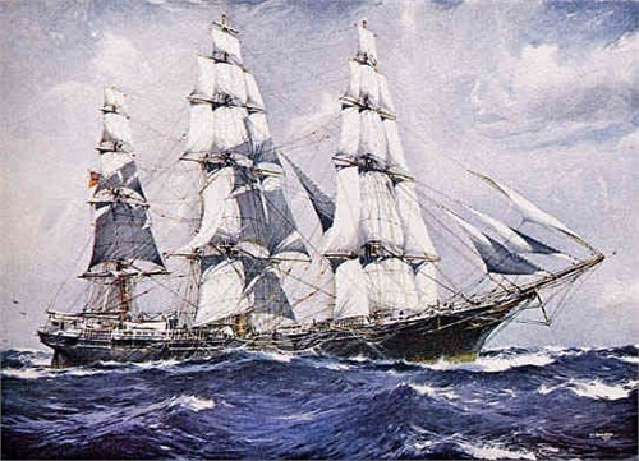
The Clipper named Ann Dashwood. Courtesy - ancestry.com Ref Mc Menamin.
William, and his brother John Russell Calvert, were two of our quite early emigrants to Victoria in 1853, who were very active working and investing on the Gold Fields near Ballarat, then started family trend to move to East Gippsland, to become farmers and graziers. William sent word to his wife Catherine, to bring their son to Victoria ( in 1855 ) as he obviously recognised the potential to start a great new life in Australia.
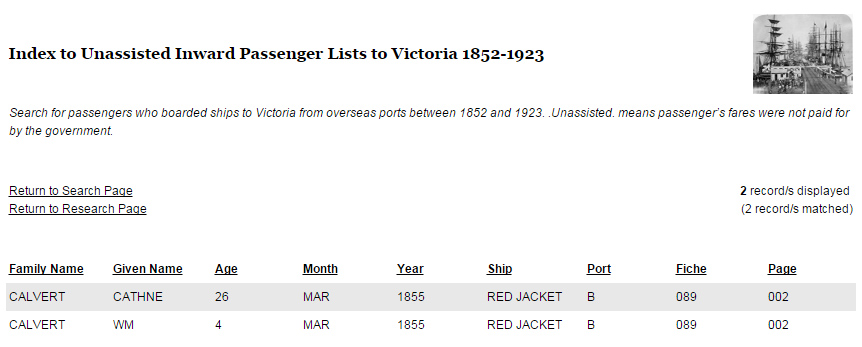
Emigration record of Catherine Calvert nee Hewitson & son William Hewitson Calvert on board the Red Jacket in 1855.
Naturally, like most of their fellow miners from Northern England, these two brothers highly valued and exercised great networking of family and friends in most mining ventures wherever possible.
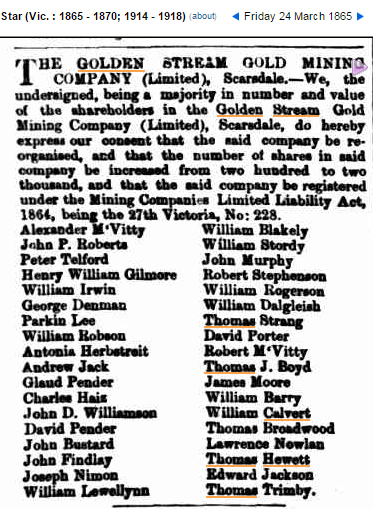
A sample investment by William Calvert in the Golden Stream Gold Mine at Scarsdale in 1865.
The above is a basic example of good networking on the diggings, where William Calvert teamed up with his brother-in-law Thomas Broadwood ( Sarah Calvert's husband ), friend Parkin Lee from Ninebanks, as well as a Robson relative.
According to the Victorian Heritage database, between May 1862 and Aug 1874, the Golden Stream Gold Mine on Basin Road Scarsdale recorded total production of 59,009 ozs 11 dwt 9 gr (or 1835.445 kg). Scarsdale was a place of family interest, as it was where one of our researcher's Great Grandfather's William Coulson Calvert Liddell was born 1875.
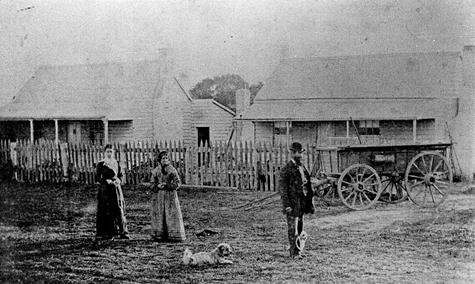
Township of Scarsdale in 1880. Courtesy Museum Victoria.
In comparison too other family members, William Calvert focussed upon a few effective investments in very local Gold Mines, primarily being the Nelson and Wellington Gold Mining Co. at Sebastopol, The Golden Stream Gold Mining Co. at Scarsdale, and the Try Again Gold Mining Co. at Piggoreet.

Historical poster Nelson and Wellington Gold Mine at Sebastopol ( partial top view ). Courtesy State Library Victoria.
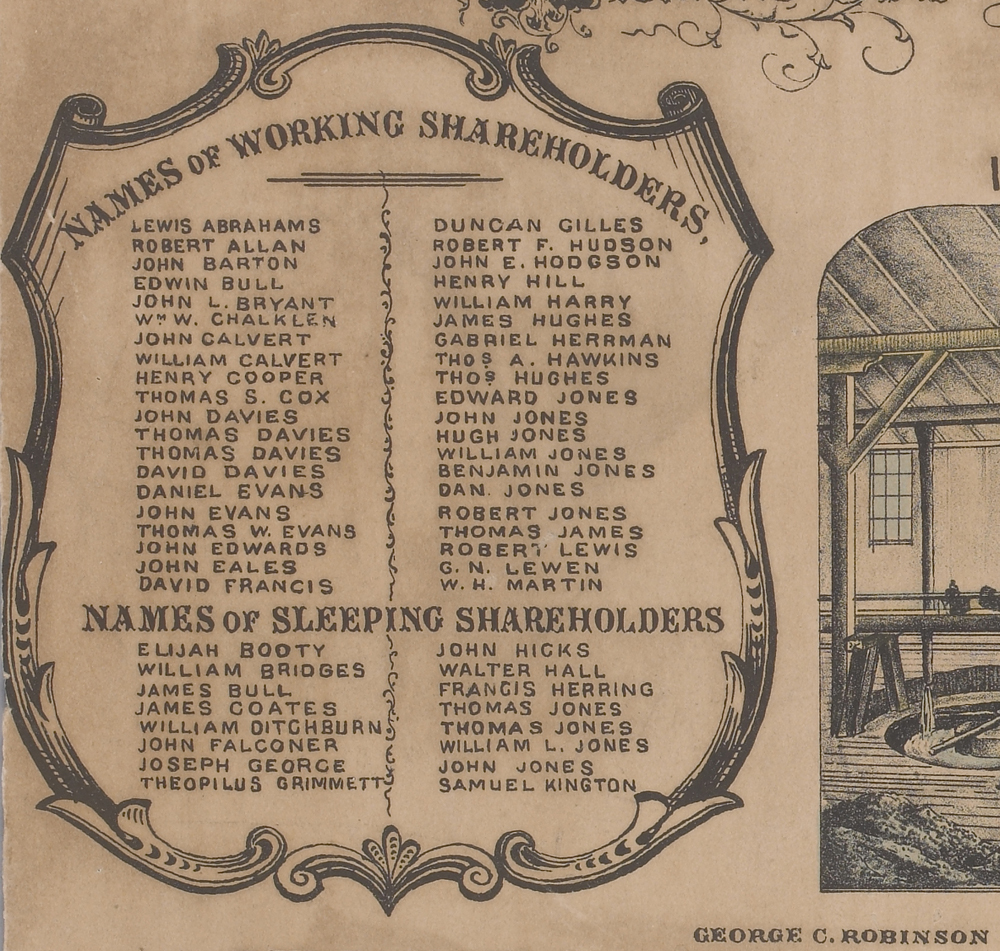
Inset of Nelson and Wellington Gold Mine poster re William and John Russell Calvert. Courtesy State Library Victoria.
From a more personal / family viewpoint, William and family and his brother John Russell Calvert learnt of good farming land for sale near Bairnsdale in East Gippsland, where they purchased land, and farmed and grazed cattle till 1885. Apparently due to a health complaint of their only son William Hewitson Calvert, it was recommended by their doctor that a dryer climate would be more compatible for William and Catherine's son, so they moved to Molong and later to Forbes in southern New South Wales.

Portrait by photographer F. Howe of William Hewitson Calvert at Forbes, New South Wales - Circa early 1900s.
Family folklore on Ancestry.com claims they sold their property, and left for the colony of New South Wales with some £30,000 in their saddle bags, a huge fortune of those days.
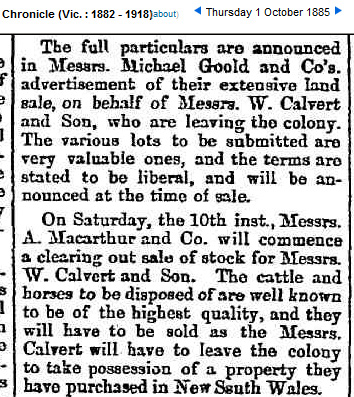
Sale notice of William Calvert's farms on the Mitchell River in 1885.
As described in tribute ( after the death if his mother ) in the Nepean Times paper at Penrith N.S.W. in 1919, William and Catherine's only son William Hewitson Calvert was quoted as saying
"Father followed mining at Ballarat and Smythesdale for some years, then he and his brother selected land at Bairnsdale, Gippsland, in 1862. His brother {John Russell Calvert} looked after the fencing-in of the land selected. Then we all went to Bairnsdale in I866, and started farming and fattening cattle." Others who followed this lead to East Gippsland were branches of our Richardson, Armstrong, Cochrane, Bell, Coulson, Liddell, Vipond, and Allison relations.
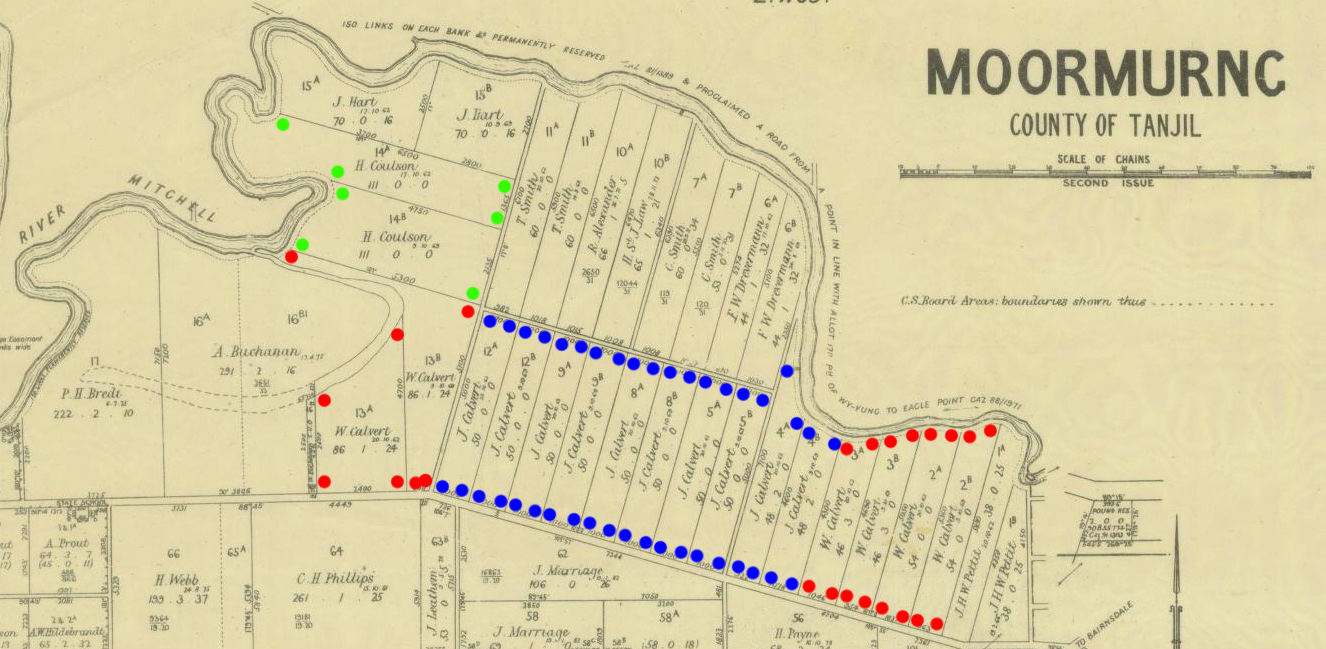
Wy Yung - Moormurng Parish map circa 1880s - Courtesy State Library of Victoria - Mitchell River on edge of Bairnsdale.
Borders of blocks of land owned by Hugh Coulson are in light green, those blocks bought by John Russell Calvert are highlighted in blue, and the borders of titles held by William Calvert are featured by red dots.
For an extensive overview of the family of William Calvert and his ancestors, please review our Calvert Family Tree.
Parkin Lee.
The following is a brief summary of a Churchill Fellowship study about Parkin Lee, thankfully provided by Roger Morris of the North Pennines, with due credit to Judith D. Lee and her Lee Family research publication.
Parkin Lee's father William was quite a wealthy man from shares he held in the silver rich Hudgill Lead Mine near Alston around, and he invested well in the Ninebanks estate pertaining of some 344 acres. William and his wife Phyllis had Parkin in 1827 at home in the recently built Mansion house on the property, which included the Manorial title of Squire, when purchased. After the death of his father William, Parkin was granted a substantial inheritance, on top of means of support in the 1851 census noted as "Landed Proprietor".

1851 Census for Parkin Lee, Squire of the Ninebanks Estate.
Parkin undertook a few voyages to Australia, firstly in 1855 for a bit over a year, then returned home to sell the Ninebanks Estate, which is reported to have raised £10,500, he wished to invest in gold mines. Its likely the appeal of striking it rich with a large amount of capital to invest, was east encouragement for Parkin to came back to Victoria again in 1859 on board the Kent, a timber clipper.

Unassisted Passenger record for Parkin Lee in 1859.
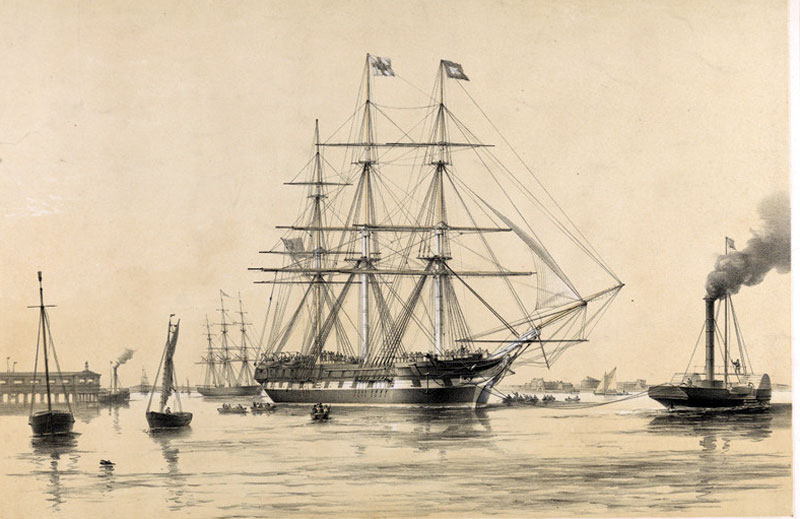
The Kent - a wooden clipper built in 1853. Courtesy 19thcenturyshipportraitsinprints.com
Records indicate Parkin Lee made substantial investments in a number of Gold Mines in the area where our Armstrong, Clementson, Liddell, Coulson, Calvert, and Broadwood relatives were living and mining for gold, with full-on vigour. These included the Grand Trunk Lead Gold Co., Golden Stream Mining Co., Nonpariel Gold Mining Co., the All England United Gold Mining Co., the Atlas Gold mining Co, and probably others as well.
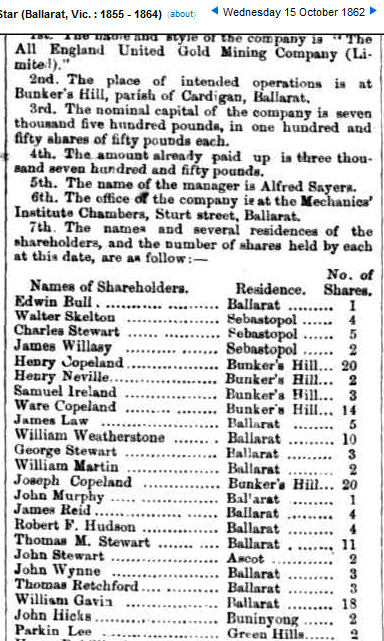
Shareholders listing of the All England Gold Mining Co. at Bunkers Hill, Cardigan, in 1862, including Parkin Lee.
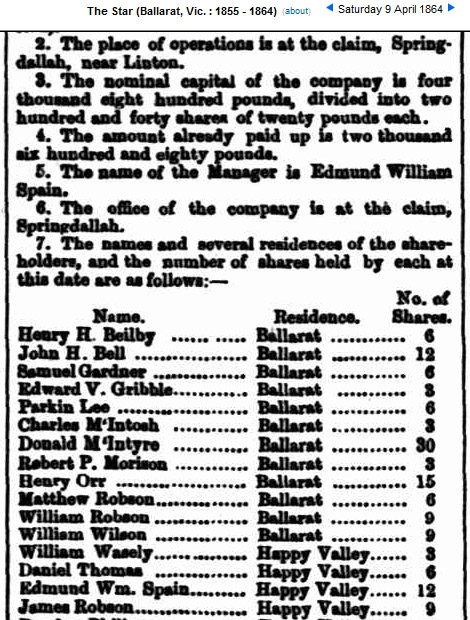
Non Pariel Extended Gold Mining Shareholders at Springdallah in 1864
NB. Matthew, William and James Robson had shares in this Gold Mine too.
Apparently one of Parkin's earlier and larger investments was four shares worth £1000 in the Cleft in the Rock Gold Mine. The Cleft in the Rock and the Try Again Gold mines were major family concerns, and although it is debateable whether or not the Cleft in the Rock was all that profitable, between 1860 to 1873, the recorded gold production of the Try Again, was 27,425 oz (or 853.018 kg). Ref 1229 Mining Surveyor Ray Supple in 1873.
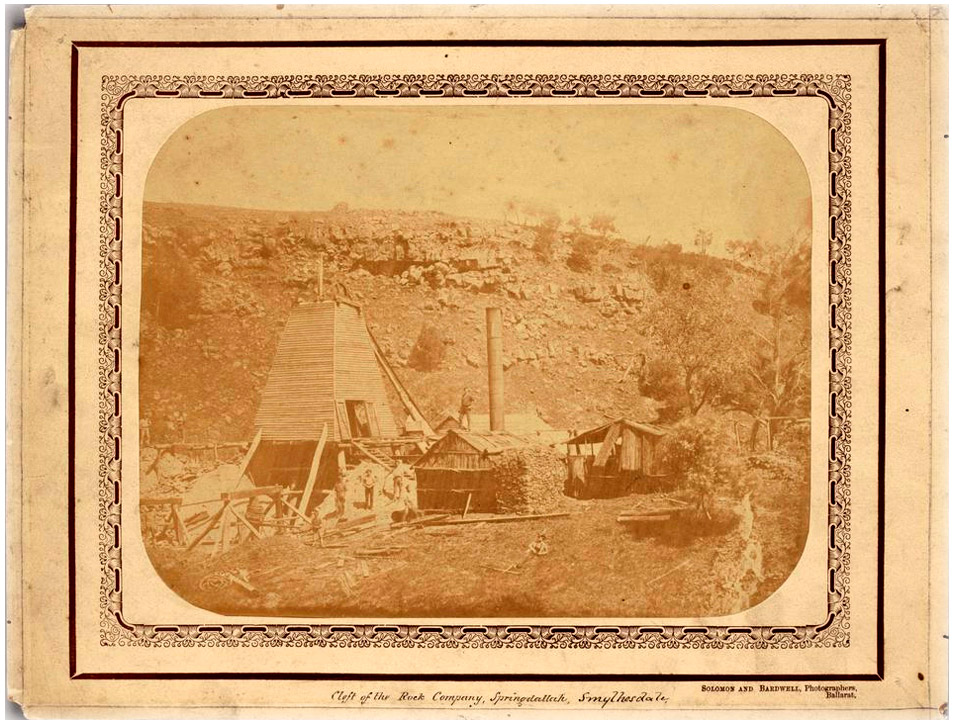
Cleft in the Rock Gold Mine in 1860, with some of the original workers on site. Courtesy State Library Vic.

Shareholders Notice, Cleft in the Rock Gold Mining Company, Ballarat Star 22nd Feb 1864.
Kindly note - the top 5 Shareholders are all Richardson family relatives, detailed in this site.

Public notices about the Try Again and Atlas Gold Mines in 1868. Courtesy Ballarat Star and Trove.
Parkin lee returned to England yet again on board the S.S. Suffolk in 1866 when he is thought to have raised more investment capital, and he came back to Victoria again, in May 1867 on the S.S. Norfolk. Little more info is known about Parkin Lee from the 1870s, apart from he had no immediate family, old time Northumberland folklore claims, "the hapless former Squire died in poverty and blindness left holding only fond memories of his native dale."
Lucky Womans.
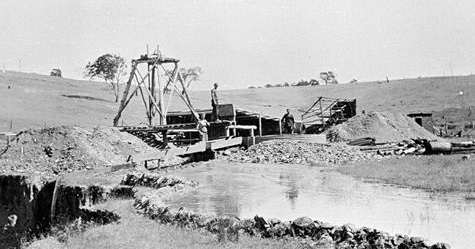
Lucky Woman's Diggings near Happy Valley circa 1935. Courtesy State Library Victoria
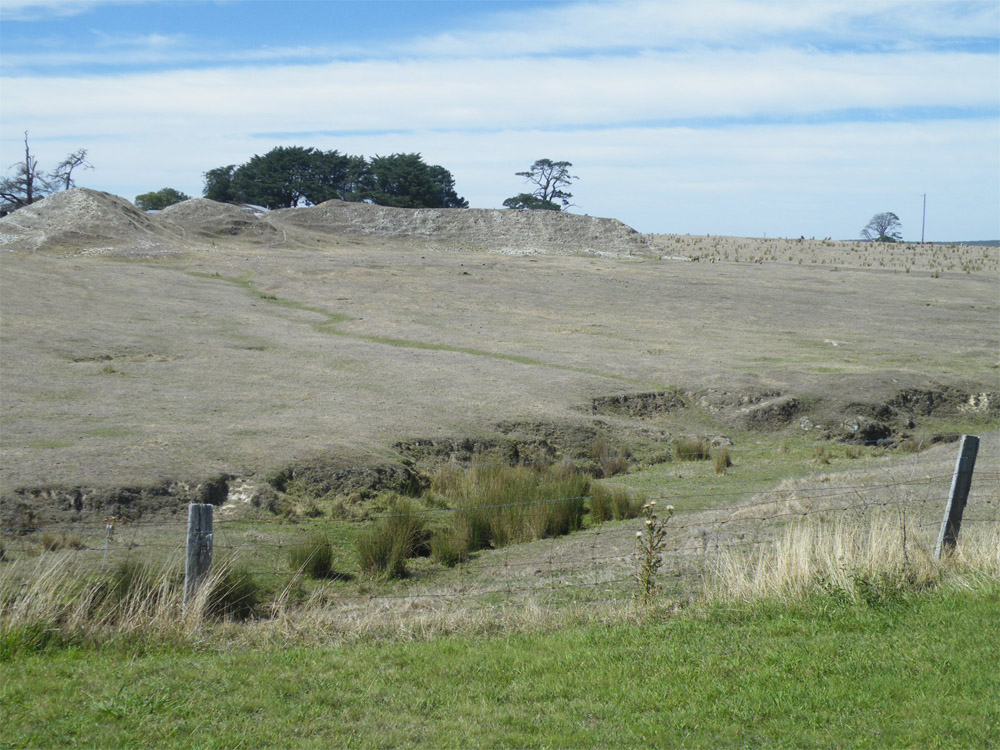
Remnants of The Lucky Womans Gold mine between Piggoreet and Happy Valley - 2015. Courtesy Mixo Sydenham
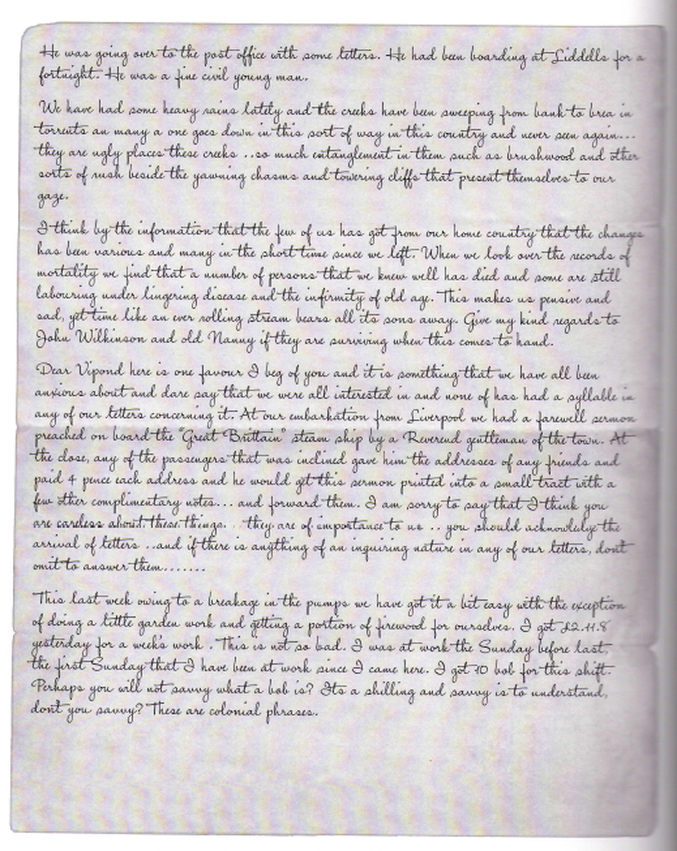
John Wilkinson.
The obvious Armstrong / Wilkinson family connection is that of James Armstrong's mother Jane Wilkinson and his father Joseph Armstrong, however finding a direct family link with a John Wilkinson has proven fruitless.
Old Nanny.
Annie Alice Armstrong, an aunt of James Armstrong was baptised Nanny Armstrong in Aug 1808 at Ninebanks. Ancestry records indicate Nanny was George Armstrong's mother, ( as outlined above ), however it appears George J. and his sister Mary J. may have been born out of wedlock. Nanny Armstrong lived her early years in Allendale, married William Makepeace in 1829, later moved to Bishopwearmouth in the 1860s, and she passed away at Westoe Durham in 1879.
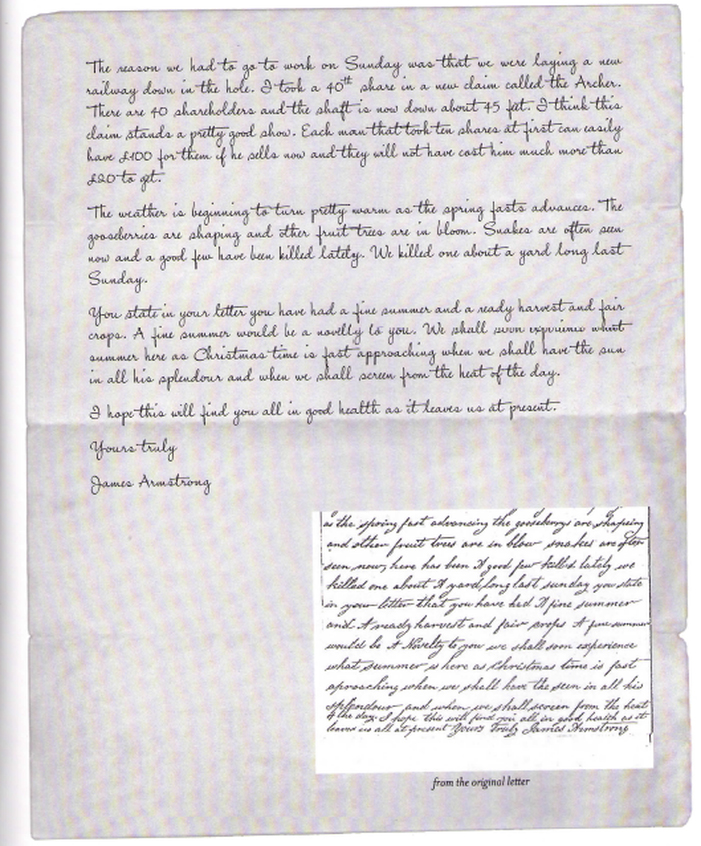
Reproduced transcripts of letter from James Armstrong at Springdallah, Victoria in 1853 to Vipond Clementson Allendale UK. Courtesy Anderson Family History.
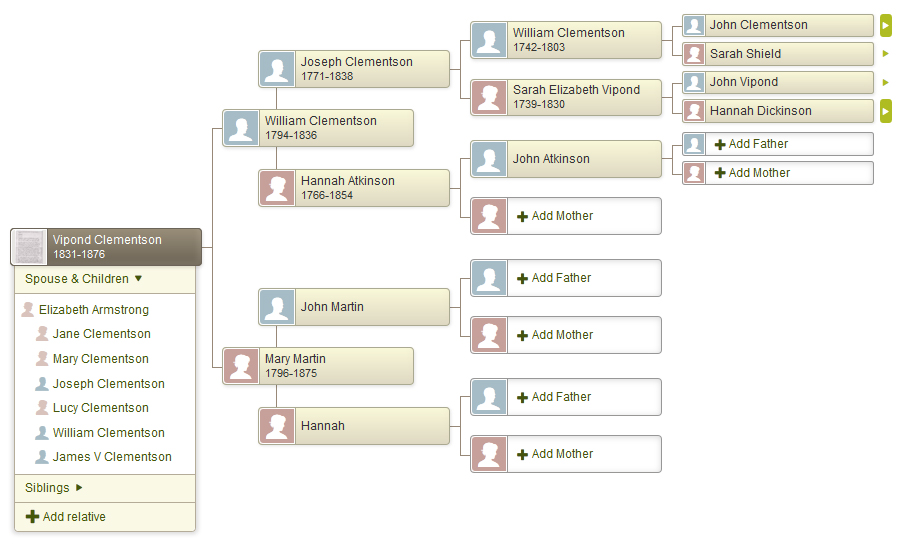
Timeline of Vipond Clementson and Elizabeth Armstrong
Letter number 2 from William Armstrong at Devils Kitchen via Piggoreet, written on 22 Aug 1864 to his brother.
Firstly, we can not be exactly sure who this letter was actually addressed to, however at this time back in 1864 William Armstrong still had 2 blood brothers Joseph and Edward Armstrong, plus 2 brothers-in-law, John Harrison and Vipond Clementson, living back in the "old country" of northern England. William Armstrong's letter show here, was not as lengthy, descriptive, or informative, as that of the earlier letter of 1863 by his brother James, yet it has raised similarly interesting mysteries.
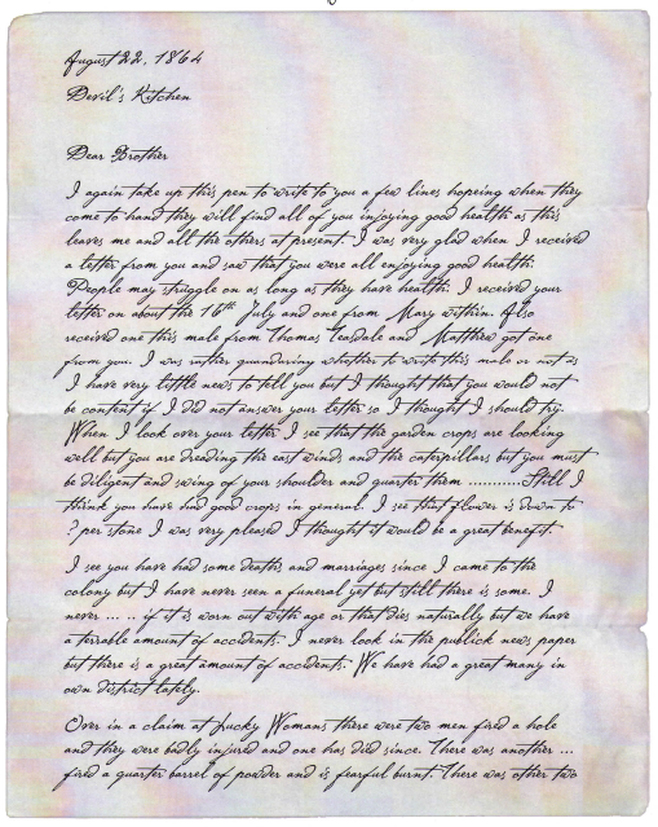
Thomas Teasdale and Mary.
A similar mystery surrounds William's mention of a Thomas and Mary Teasdale, as with James Armstrong's letter above.
An accident on a claim at Lucky Womans.
Mining accidents on the Victorian Gold Fields were prolific throughout this era - there is a database of 9100 names of mining accident victims available from 1850 - 1940. For example, there is one listing for a death at Lucky Womans by the very common cause "Fall of Earth" during the year before this letter was written, plus a newspaper report of 27 July 1864, which could have been the incident that was still fresh in William's mind when he took to pen in hand in August 1864.
Griffiths, Richard 1863/00/00 Killed, Fall of earth, Ballarat District, Lucky Womans Division
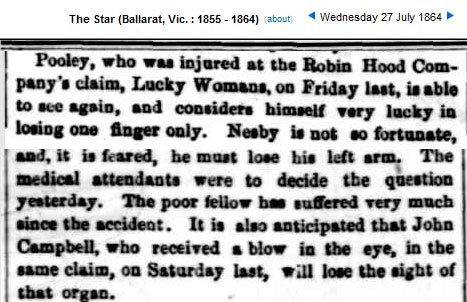
Newspaper report of a local mining accident at Lucky Womans in July of 1864.
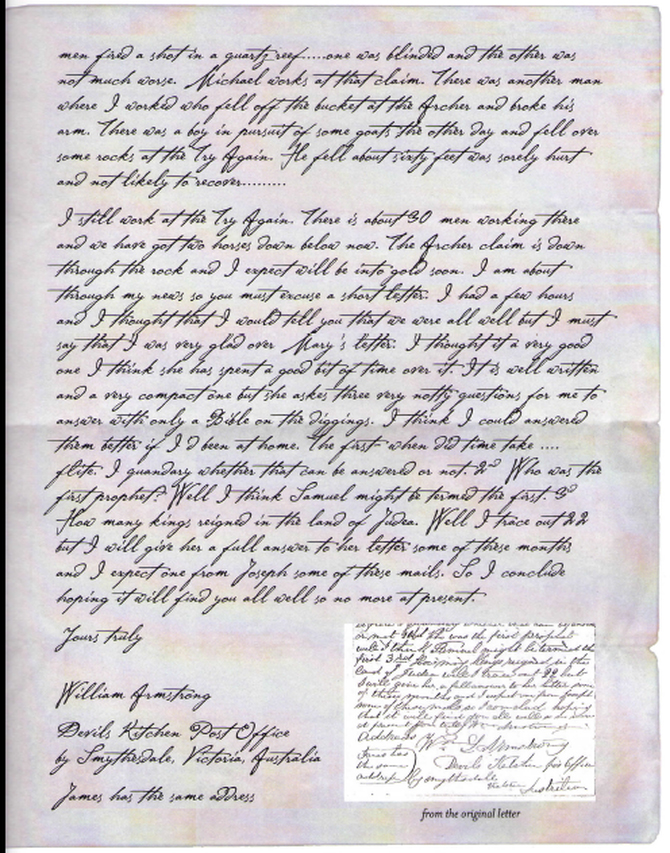
Michael.
The only close family member named Michael known to be in this area during this period, is William Armstrong's nephew ( by marriage of sister Anne Armstrong to Matthew Clementson ) Michael Clementson, who accompanied William and James Armstrong on board the S.S. Great Britain, from Liverpool to Melbourne in 1863. Michael Clementson was born in 1838 at Allendale to Joseph Clementson and Mary Henderson, married Honora Richardson in Victoria, and had 4 children locally at Springdallah between 1866 and 1873.
The Archer and The Try Again Gold Mines.

James Armstrong and William Johnson, Shareholders in the Archer Gold Mine at Piggoreet in 1863.
The Archer Gold Mine Shaft was basically next to the Liddell's Try Again Hotel at the top end of Piggoreet township, and the Try Again Mine was at the Devils Kitchen, nearly a mile away. Not much material has been located about the Archer Mine, since its commencement of Shareholders around 1863, and it appears it did not pay so well shortly after this letter was written. Some £780 of equipment was bought from the Archer Mine by the Western Creek Grand Junction Company in April of 1865, indicating The Archer had production and financial problems. Also Piggoreet resident and miner William Muncey filed for insolvency in 1865, claiming mining losses in the Archer Mine as a major cause for bankruptcy.
If interested, click the link for an in-depth overview of the workings, reports, and shareholders of the
Try Again Gold Mine.
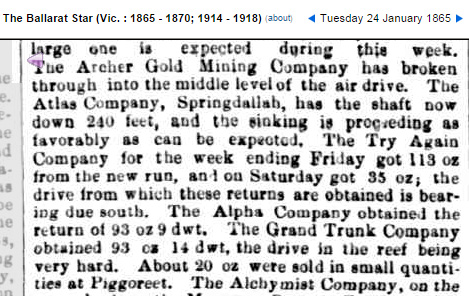
Mining intelligence report in the Ballarat Star of 1865.

Back to Site Index.

Background into Lead Ore Mining in Northern U.K.

Background into the Gold Rush days near Ballarat Victoria.

From Joseph Richardson born 1721 at Alston, U.K.

From John Armstrong born in 1705, Haltwhistle U.K.

From William Calvert born 1791 at Kirkhaugh, U.K.

From John Clementson born 1692 in Garrigill, U.K.

From William Coulson born 1760 in Cumberland, U.K.

From Robert Cochrane born 1778 in Eglington, U.K.

From Thomas Bell born 1806 of Allendale, U.K.

From Edward Hewitson born 1794 in Kirk Linton, U.K.

From James Broadwood born 1796 of Northumberland, U.K.

From Joseph Parker born 1810 at Allendale, U.K.

From Nicholas Vipond born 1655 in Alston, U.K.
Email here re enquiries, corrections, or input to this site